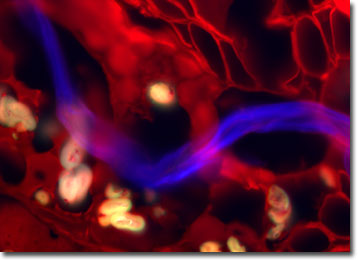Fluorescence Digital Image Gallery
Pine Root
The root system is the part of a plant that normally grows underground. Its primary functions are anchorage of the plant, absorption of water and dissolved minerals, conduction of these to the stem, and storage of reserve foods. Gymnosperms, such as pine trees, have a taproot system. A primary root, or taproot, emerges from the seedling and secondary roots grow laterally from it. The taproot grows deep into the ground, enabling the tree to withstand long periods of drought.

Many pine tree roots are parasitized by ectomycorrhizal fungi. Although these fungi can sometimes cause a tree to die, many live symbiotically with the trees, enhancing water and nutrient (particularly phosphorus) uptake. In return, the trees provide carbohydrates for the fungi. Some ectomycorrhizal fungus species produce edible mushrooms, such as porcini and matsutake. Matsutake (matsu = pine; take = mushroom) is the collective Japanese common name for these mushrooms. Matsutake has been considered an autumn delicacy in Japan for hundreds of years and fills a niche in the Japanese gourmet market similar to truffles in Europe.
Pine is the common name for any species belonging to the genus Pinus, a member of the family Pinaceae, coniferous trees with needle-like leaves. Pinaceae is the largest family of conifers, consisting of about 262 species, and includes fir, larch, spruce, hemlock, and cedar. Pine trees are found worldwide, primarily in northern temperate regions. Typically they have woody stems covered in bark, which protects tissues that conduct nutrients and water. When harvested, they provide materials like lumber, turpentine, rosin, paper, and pulp, fuel.
The specimen presented here was imaged with a Nikon Eclipse E600 microscope operating with fluorite and/or apochromatic objectives and vertical illuminator equipped with a mercury arc lamp. Specimens were illuminated through Nikon dichromatic filter blocks containing interference filters and a dichroic mirror and imaged with standard epi-fluorescence techniques. Specific filters for the pine root stained thin section were a UV-2E/C, B-2E/C, and a Y-2E/C. Photomicrographs were captured with an Optronics MagnaFire digital camera system coupled to the microscope with a lens-free C-mount adapter.
BACK TO THE FLUORESCENCE DIGITAL IMAGE GALLERY
